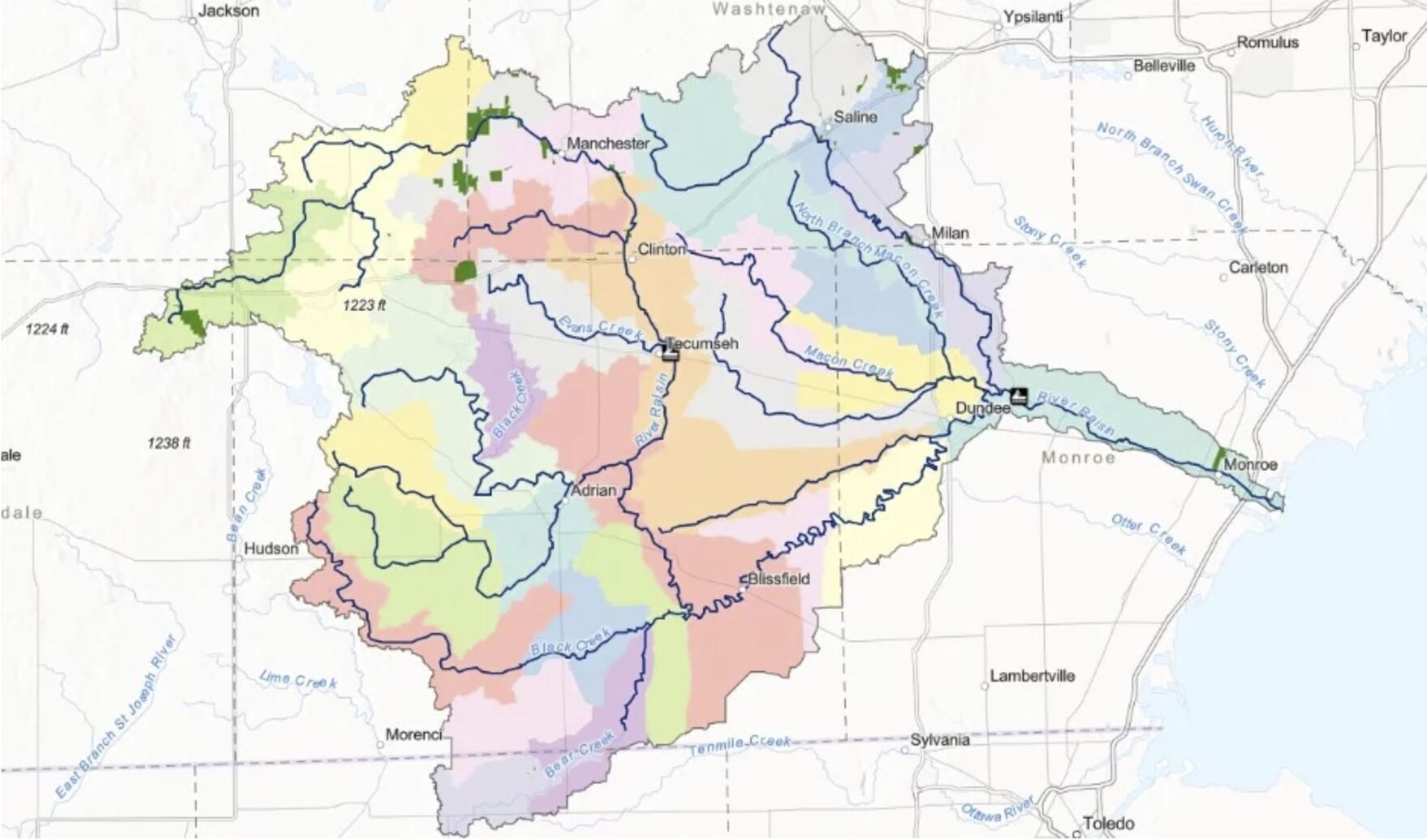
By Lester Graham, Michigan Radio
The Great Lakes News Collaborative includes Bridge Michigan; Circle of Blue; Great Lakes Now at Detroit Public Television; and Michigan Radio, Michigan’s NPR News Leader; who work together to bring audiences news and information about the impact of climate change, pollution, and aging infrastructure on the Great Lakes and drinking water. This independent journalism is supported by the Charles Stewart Mott Foundation. Find all the work HERE.
A lot of people blame farms in Ohio for the cyanobacterial blooms in Lake Erie. Fertilizer runoff is blamed for the explosion of the harmful algal blooms. But Michigan’s River Raisin also drains into Lake Erie after passing through farmland in four counties. Now, farmers are talking about what — if anything — they should do.

The River Raisin watershed is primarily farmland in Jackson, Washtenaw, Lenawee, and Monroe counties. (Photo courtesy of River Raisin Watershed Council, The River Raisin Institute, And The Washtenaw County Water Resource Commissioner’s Office via Michigan Radio)
One of the keys to reducing fertilizer runoff is soil conservation. Instead of plowing up the field every year, more progressive farmers are using no-till or low-till methods that don’t disturb the soil as much and allow them to use fertilizer more precisely, in the amounts and spots needed. That means less gets washed into ditches and streams during heavy rains.
But only about one-third of farmers use no-till.
“Agriculture is no different than any other section of society. You’ve got your innovators, your early adopters, your mass that comes along,and then there’s always going to be a percentage that are just aren’t going to do that,” said Joe Kelpinsky with the Michigan Department of Agriculture and Rural Development. He runs the Michigan Agriculture Environmental Assurance Program, which certifies farms that meet certain environmental criteria.
There are a lot of reasons why some farmers don’t or won’t give up plowing the fields.
Dan Moilanen, with the Michigan Association of Conservation Districts, organized a gathering of farmers on a farm near Palmyra, Mich., to hear firsthand from people who have been using low-till methods successfully. It’s part of a new effort called Farmer-Led Watershed Conservation.

Dan Moilanen is the Executive Director of the Michigan Association of Conservation Districts. (Photo Credit: Lester Graham/Michigan Radio)
Moilanen says one thing that’s slowing the pace of change is that the average age of today’s farmer is 65.
“So you’ve got a lot of folks that are a little bit toward the end of their farming career and they don’t want to make that investment to adapt to these new practices.”
Some farmers, perhaps 30%, have switched to no-till just because it makes sense to preserve soil and not pay for more fertilizer than necessary.
But environmental concerns are becoming more pressing. Toledo temporarily shut down its water system in 2014 out of concern about toxins from larger areas of cyanobacterial blooms. Since then, public pressure to do something has been growing.
Bob Platt said he’s been totally no-till on his farm near Tipton, Michigan for 13 years. He said most of the farms in his area are not.
“I think there’s a concern, but I think a lot of them are just blowing it off a little bit. And in reality, I mean, I hate to say that,” he said.
Many of the Michigan farmers feel the problem is an Ohio problem, because the drainage area into Lake Erie is so much larger in that state. They don’t feel Michigan farm runoff is really enough to make any difference.
Platt added that some of them also believe if there is a problem coming from Michigan, it’s because wastewater plants sometimes dump raw sewage into the rivers during heavy rains.
“In all honesty, that’s where I hear a lot of the people put the blame.”
The farm where this event was held is owned by the Isley family. The father, Jim, calls his son, Jake, the brains of the operation.

Area farmers gather around as Jim and Jake Isley talk about the kind of adjustments they’ve made as they’ve implemented low-till farming over the last several years. (Photo Credit: Lester Graham/Michigan Radio)
Jake told the group gathered that he wants to use these conservation methods to make the soil better now and for future generations. He added that it means fewer times they have to run a tractor and equipment across the fields and that reduces fuel consumption.
He said he also wants to do better for environmental reasons, but he thinks it’s a mistake to put all the blame for the cyanobacterial blooms on farming.
“Is it completely the problem? Absolutely not. There are a lot of factors that lead to that, that algal bloom. But as agriculture, I still think we have a lot of the solutions to be able to help fix some of those issues as well.”
For those farmers that are considering no-till or low-till farming methods there are obstacles. One big hurdle is having to buy different equipment. It can run into hundreds of thousands of dollars and there’s no guarantee that their harvests will be any better.
Moilanen, with the association of conservation districts, said that’s where government could help.
“We really need more state involvement in terms of the financing component. And I think making the federal process a little bit easier too will be great,” he said.
Governor Gretchen Whitmer wants a 40% reduction in phosphorus runoff from Michigan that’s feeding the cyanobateria blooms in Lake Erie.
Low interest loans and better incentive programs could make the difference in getting more farmers to go no-till and reduce that nutrient load.
Moilanen said he wants to see the state and federal governments offer more carrots, before using a stick.
“Eventually there may be a regulatory response to this, but if we can prevent that from getting to the point, if we can engage with those targets and reduce that phosphorus and that nitrogen issue, you know, we can we can hopefully prevent that from happening,” he said.
Catch more news at Great Lakes Now:
New web scanning technology helps protect the Great Lakes from invasive species
NOAA doubles five-year grant to $53 million for Great Lakes researchers at University of Michigan
Featured image: Jim Isley, left, and his son, Jake, right talk to other farmers about their experience in implementing low-till methods at their farm near Palmyra, Michigan. (Photo Credit: Lester Graham/Michigan Radio)




